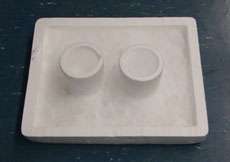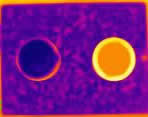Abstract

see cups of ice water (R) and
liquid nitrogen (L) against a
background of dry ice.
Ice water glows strongly on an infrared thermal camera compared to nearby dry ice and liquid nitrogen.
Portable
Yes
Principles Illustrated
Introduction
All surfaces at temperatures greater than absolute zero glow. This glow is often called blackbody radiation and it is proportional to the 4th power of the absolute temperature of the surface (and the emissivity of the surface). So yes, even a glass of ice water glows. It just glows less than a cup of hot tea.
In the photos above we have two Styrofoam calorimeter cups in a shallow styrofoam box filled with dry ice (-80°C or 193 K). One cup contains ice water (0°C or 273 K) and the other contains liquid nitrogen (-196°C or 77 K). Notice the ice water looks quite warm on the infrared thermal camera compared to

an infrared camera. Surfaces
that are glowing most
appear white, those
that glow least
appear black.
the dry ice and liquid nitrogen. But not as warm as the rim of the styrofoam cup which is closer to room temperature.
More detailed discussion
The power radiated per square metre of surface is given by the Stefan-Boltzmann Law
In this equation,
P is the radiated power (watts)
T is the temperature (kelvin),
![]() is the Stefan-Boltzmann constant,
is the Stefan-Boltzmann constant,
and ε is the emissivity (blackness) of the surface, a dimensionless number.

an artificial colour palette applied.
Here yellow is bright and dark blue
is dim.
A true blackbody is perfectly black. In other words, it is a perfect absorber of radiation, and thus emissivity ε = 1. All of the visible light, all of the ultraviolet, infrared, microwave, and other electromagnetic radiation that strikes the surface is absorbed. A perfect absorber is also a perfect emitter. A blackbody surface glows more than any other surface at the same temperature. Surfaces that are not blackbodies have emissivity ε < 1
The glow that one sees from an object on an infrared thermal camera depends on the temperature of the object’s surface and also the emissivity of the surface. This makes quantitative work with infrared thermal cameras more challenging. They can be used to measure temperature from a distance but the widely varying emissivities of common surfaces complicate matters. One might try to repeat this demonstration with, for example, copper blocks cooled in ice water, dry ice, and liquid nitrogen. That might give a more quantitative result, but the emissivity of copper will depend strongly on how oxidized it is and also on its temperature. In short, thermal imaging cameras are great tools for qualitative work and can be used for quantitative work as well but not easily.
NCEA & Science Curriculum
Extension
Instructions
See safety notes below. Teachers in the Wellington area can borrow our IR camera or we can bring this demonstration to your school. IRL has an IR camera that can be borrowed by schools throughout the country with some notice.
Safety
Be sure to use fairly thick styrofoam that can withstand cooling. And, as always, handle dry ice and liquid nitrogen using standard safety precautions. Both are potentially dangerous. If you are not trained in the handling of these materials ask a university physics or chemistry department for advice.
Individual teachers are responsible for safety in their own classes. Even familiar demonstrations should be practised and safety-checked by individual teachers before they are used in a classroom.
Related Resources
- Thermal Camera
- Infrared Webcam
Teaching Resources
Would you like to contribute lesson suggestions? Contact us.
Credits
This teaching resource was developed with support from
The MacDiarmid Institute
Faculty of Science, Victoria University of Wellington
School of Chemical and Physical Sciences, Victoria University of Wellington